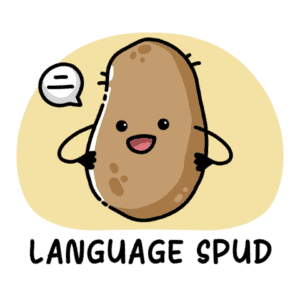To many a learner of Mandarin Chinese, learning characters can, at some stage, feel like a laborious and soul-destroying task. After all, there are literally thousands of characters to learn. Learning all of them seems like a rather daunting task.
The good news is you don’t have to learn them all to be an accomplished Mandarin Chinese speaker, reader, or writer.
If you’re questioning whether you learning methods are still working or whether you need to mix things up, check out the following strategies and resources I’ve compiled to help you learn Chinese characters quickly and effectively.
You’ve got to Understand the Radicals, Man
It may sound like annoying, hippy-dippy hogwash, but it’s true.
Think of Chinese radicals and components as LEGO. Except, there are way more funky and bendy pieces than usual.
Radicals and components are the building blocks of Chinese characters, and I’ve written about them in more detail here.
If you’ve never seen a character before but you’re familiar with it’s radicals and components, you can often deduce meaning from new characters.
Let me give you an example.
The word ‘eat’ in Chinese is 吃 (chī). The radicals of this word are 口 (kŏu) meaning ‘mouth’ and 乞 (qĭ) meaning ‘to beg’. Shove these radicals together and you’ve got yourself a word.
This works when you have words that are two or even three characters together. I’ll give another example using one of the radicals (which is also a character in itself) that I showed you before.
口 (kŏu) means ‘mouth’ and 水 (shuĭ) means ‘water’. Stick them both together and you’ve got ‘口水’. Any ideas on the meaning? If you guessed ‘dribble’ or ‘drool’ then you get a gold star.
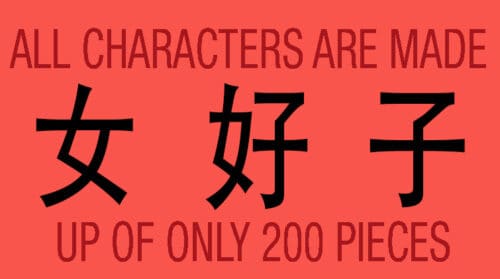
Think of the composition of Chinese characters as a mixture of building blocks and a semantic riddle.
This mindset towards Chinese characters keeps me positive and curious, and this has been paramount to my progress.
Here is a very helpful, free PDF download of the 100 most common Chinese radicals. Make them the first things you learn on your Mandarin Chinese journey. You can copy and paste them into any self-made course on the apps I’ll be discussing now.
The Spaced Repetition System (SRS)
We live in a modern world with a heavy technological presence and there’s no getting away from that. I’m not sure I’d want to at this point. If I’d spent all this time learning characters with a pencil and paper, I would have contributed a lot to the death of trees, and I would have learned much fewer characters.
Spaced repetition is a learning technique based on reviewing information at gradually increasing intervals. This method works for anything you’re trying to remember, whether it be for an algebra test or to remember the names of your illegitimate children.
SRS (Spaced Repetition Software) apps are very effective in helping you learn new characters and words, but they don’t come without their controversies.
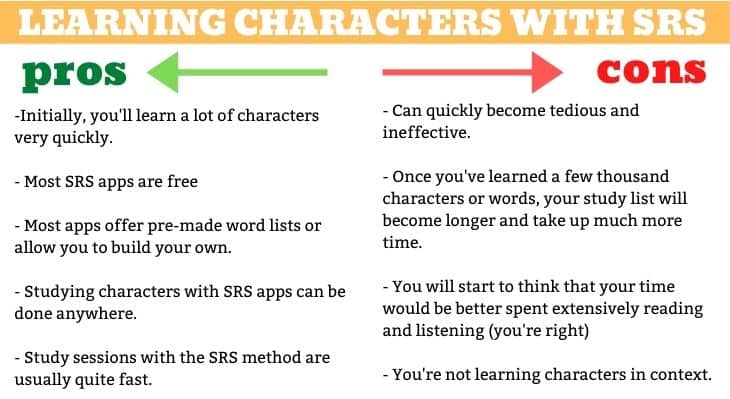
Before I briefly outline my favourite SRS resources (they’re all quite similar) I offer the following advice:
- As a total beginner, using flashcard apps with SRS can really help you learn those first few hundred all-important characters really quickly.
- If you’re at an intermediate/advanced level it’s MUCH more advantageous to learn characters and words organically through reading. Obviously you can keep using your flashcard app, but I strongly recommend using it in conjuction with extensive reading.
- If you’re at an intermediate/advanced level and you’re using flashcards, studying nouns in this way will probably be more effective.
For a more focussed discussion on using flashcards in language learning, check out my post Flashcards in Language Learning: Are They Worth Your Time?
Pleco
Every Chinese learner should have easy access to a comprehensive dictionary, and Pleco is just that – and so much much more. Seriously, you’ll find me blowing Pleco’s trumpet all over this site, and for good reason.
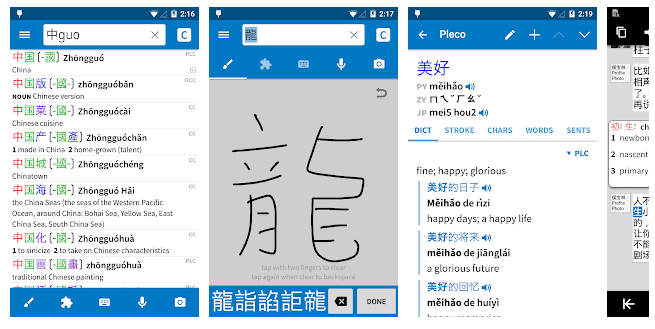
I and every foreigner I know in China use Pleco. The dictionary is free, but the basic bundle ($29.99) and professional bundle ($59.99) have some incredibly useful add-ons.
The Basic Bundle includes OCR, enhanced handwriting, flashcards, stroke order diagrams, text file reader, and more. The flashcard function is great if you don’t want a different flashcard app cluttering up your phone space, and you can use Pleco as a handwriting app as well.
I recommend making use of the flashcard function within the Pleco app.
Hack Chinese
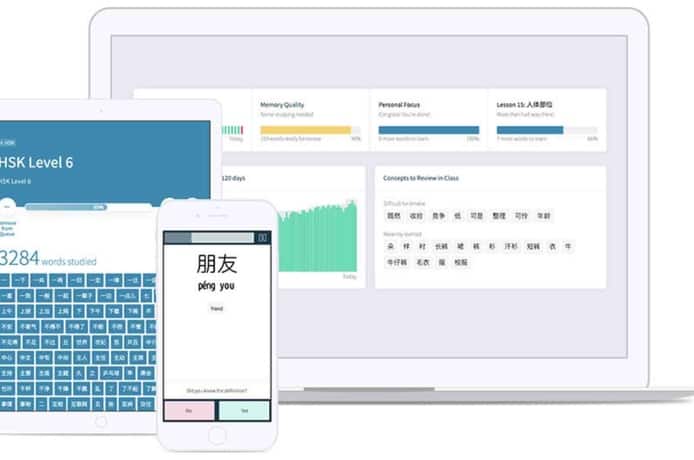
Hack Chinese is fairly new to the game, but it’s now my favourite tool for learning new characters. It’s clean, simple, effective, and very streamlined when it comes to your studies. However, it’s not an app (yet) and it’s not free…
PRICE
– One-week free trial.
– $12 per month (monthly subscription), $9 per month, (1 year), or $7 per month (two years).
In hack Chinese, the curated, dynamic vocabulary lists mean you don’t have to tinker around with other word lists to get your perfect study program.
For example, with Pleco or Anki, if I finish the HSK 3 wordlist and move on to HSK 4, I’ll have to learn all of the HSK 3 words all over again. With Hack Chinese, you can review old words and learn new ones in the same study session.
If you’re a beginner, I think the other free apps on this list will do the job just fine, but once you’re really plowing through the characters in the upper levels, consider forking out for Hack Chinese.
Anki
Anki is probably the most widely used flashcard app. With Anki, there seem to be endless ways to modify your decks and cards, and there are plenty of pre-made wordlists available to import from the Anki website. I know a lot of other language learners who swear by Anki. There are quite a few other flashcard apps out there, but I’m yet to find one with as many customisation options as Anki.
PRICE
– Free!*
– *Annoyingly for iPhone users, a one-off payment of $24.99 for the app is required. The desktop version and android app ar totally free. Still, if you end up adopting Anki as your primary mode of vocabulary learning, it becomes very cost-effective.
Memrise
Memrise is basically just a flashcard app with spaced repetition, but it’s free, easy to use, and self-made courses are easily customisable. There is a huge database of wordlists, including every HSK word list and other popular textbooks and courses for you to learn from. You can also make your own!
PRICE
– Free!
– You can unlock all features for $8.99 per month (monthly subscription), $6.33 per month (quarterly), $5.00 per month (annually) and there’s a lifetime use, one-off payment available for $99.99.
Writing Characters
Writing characters is another slightly contentious topic among foreign learners of Mandarin.
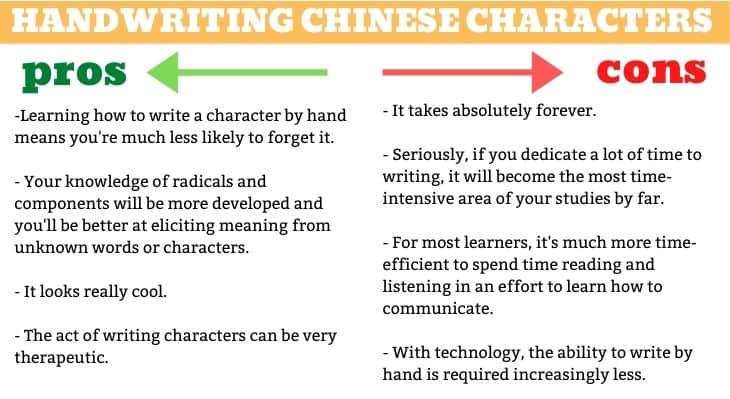
Skritter
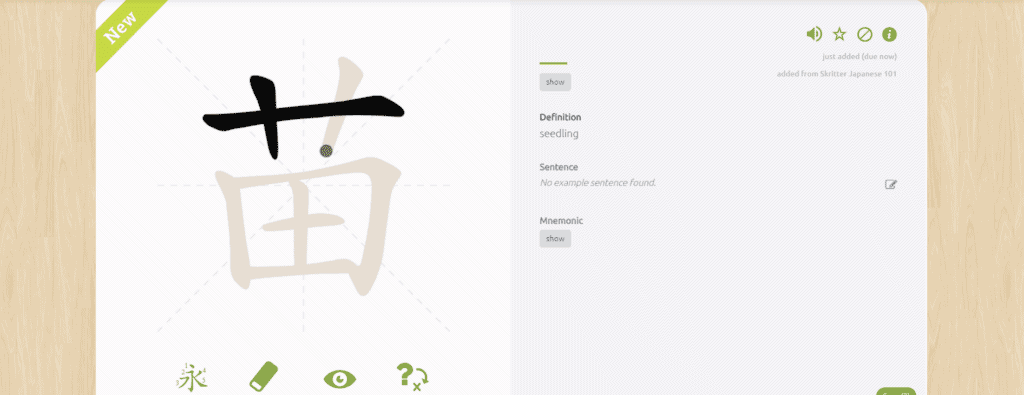
If you want to learn how to write characters by hand, nothing comes close to Skritter. It makes use of the SRS system but instead of just looking at the characters and remembering them, you’re writing them.
OK, technically, you’re not writing with the Skritter app, you’re actually finger wiping or screen scrubbing, but it still teaches you how to form the character with your hand.
Skritter provides stroke order diagrams, as well as other subtle features such as stroke suggestions and tweaks to the character presentation. The interface is immaculate and the app is very user-friendly.
PRICE
– 7-day free trial.
– $14.99 per month (monthly subscription)
– Longer-term subscription plans are 6 months for $59.99 ($9.99/mo), 12 months for $99.99 ($8.33/mo), and 24 months for $179.99 ($7.50/mo).
Handwriting Textbooks
If you’re looking for a handwriting textbook with a solid foundation and introduction to basic characters, I can recommend the following:
Basic Mandarin Chinese – Reading & Writing by Cornelius C. Kubler
Not only does this guy have a great name, but he also creates great textbooks. This book is a solid choice for beginners – a workbook for the 288 highest-frequency characters and 700 words in Chinese. Designed to have you reading and writing simple, connected Chinese sentences quickly.
Reading and Writing Chinese: Third Edition, HSK All Levels by William McNaughton and Jiageng Fan
If you’re looking for a comprehensive writing textbook, this one should fit the bill. This book could potentially lead you throughout your entire character writing journey as it covers all HSK levels from total beginner to advanced. It’s resting neatly on my shelf in my bedroom in England, largely untouched… But it looks great, and I really enjoyed the first few pages back in 2016.
Learning Mandarin Chinese Characters Volume 1: The Quick and Easy Way to Learn Chinese Characters! By Yi Ren
If you’re intimidated by the gigantic atlas of Chinese that is my previous suggestion, this one might be more up your street. It will cover all of the bases of HSK 1 and give you plenty of space to practice.
If you’re after a blank Chinese writing notebook where you can practice writing characters, there are plenty of cheap ones on Amazon.
Sentence Mining
Sentence mining is just like studying new words and characters through SRS, except you’re studying sentences instead.
I have previously mentioned how important and effective it is to learn new words in context. This is important in any language, but I feel it’s even more so in Mandarin Chinese because it’s such a contextualised language.
I tried to ignore this advice early on in my Mandarin learning journey because it was so easy to fly through some single vocabulary flashcards two or three times a day.
The result?
I was able to memorise long lists of vocabulary but I could barely string a sentence together.
Don’t make the same mistake as me. Sentence mining isn’t perfect, but it has its advantages over the rote memorisation of flashcards.
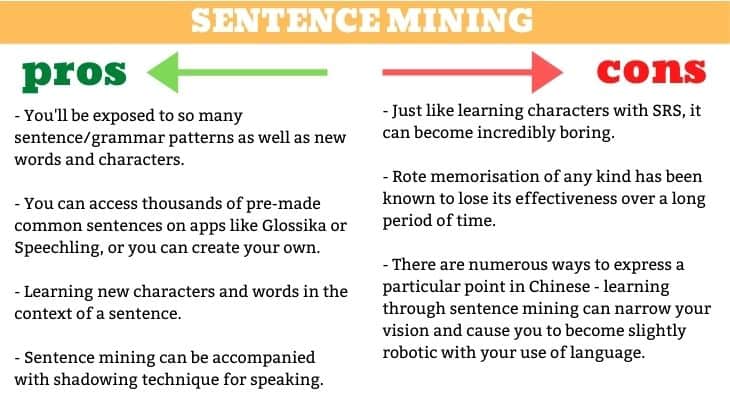
NOTE: there are two diverging methods when it comes to studying sentence mining:
- Volume: study 10,000 random sentences to give you a pretty solid base of the language. See the above resources for this kind of thing, as you’re unable to make your own sentence flashcards in both Glossika and Speechling.
- Tailored: create your own sentence cards based on your own study plan. For example, taking sentences from a textbook you’re learning so you can really drill it into your brain. If you’d prefer to study this way, use Anki.
Glossika
Probably the most well-known sentence mining tool on the market, and if used regularly over a long time you can go very far with it. However, there are a few issues with it: it’s expensive, it phonetically translates loads of weird names (unnecessary), and it’s riddled with language errors.
Speechling
Does everything that Glossika does for free. It’s an app, too. Sure, the interface is a bit messier and the app is sometimes buggy, but it’s free. You can also get your own private tutor through the paid version.
Learning Characters Organically
To reach the highest heights of Mandarin Chinese, I truly believe that extensive comprehensible input is the key.
That means lots of reading and listening.
Now if you ask everyone fluent in Mandarin, whether they’re a native speaker or not, I’m almost certain that none of them learned all of the characters and words they know through rote memorisation and flashcards.
Once you break into the realm of consuming native-level material (and long before that), whether you know it or not, you’ll be learning new words and characters organically.
So if you really want to learn characters, read, read, and read some more.
Exposure is key.
I have written more extensively on reading materials in the posts below:
- Learning to Read Mandarin Chinese | A Powerful Strategy for Newbies
- Du Chinese VS The Chairman’s Bao | Chinese Graded Reader Apps
I have compiled a list of my favourites reading materials which you can find in my resource guide here. Just skip to the ‘reading’ section.
Further Reading
- 100+ MANDARIN LEARNING RESOURCES: THE FASTEST WAY TO FLUENCY
- THE 20 BEST MANDARIN STUDY RESOURCES FOR BEGINNERS
- 10 REASONS WHY YOU SHOULD LEARN MANDARIN CHINESE
- IS IT EASY TO LEARN MANDARIN CHINESE?
- THE 21 BEST APPS TO LEARN MANDARIN CHINESE
- STUDYING MANDARIN AT A UNIVERSITY IN CHINA: WHAT YOU NEED TO KNOW
